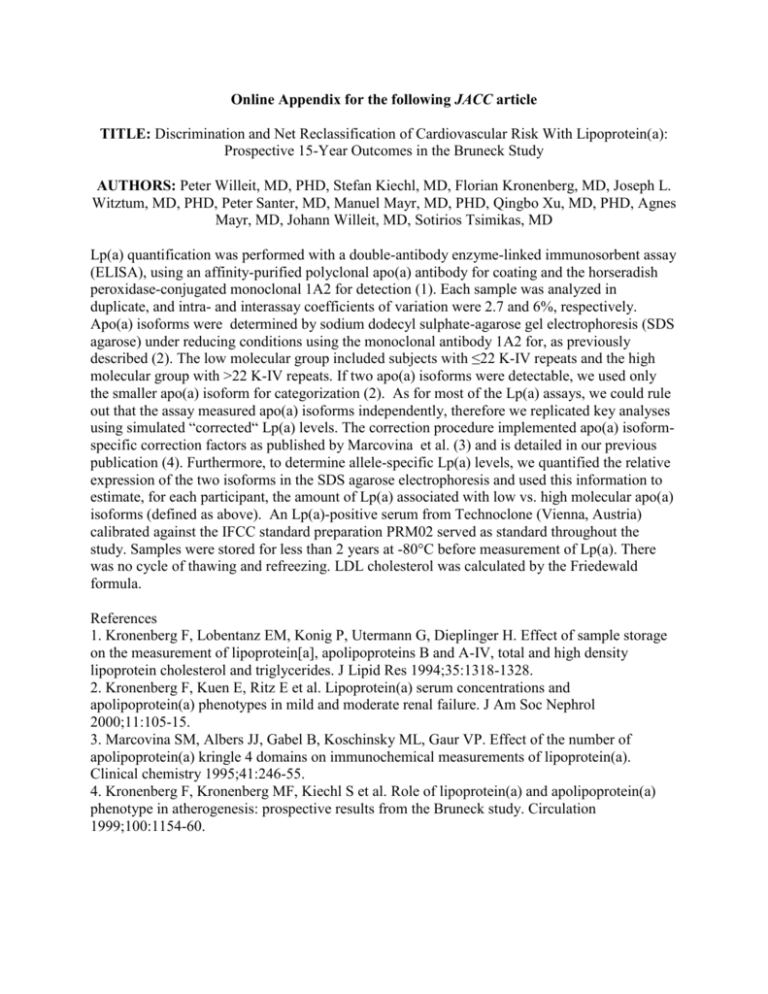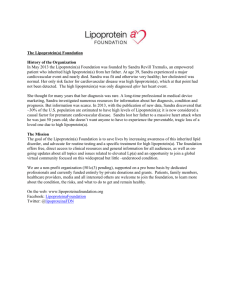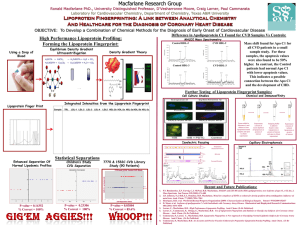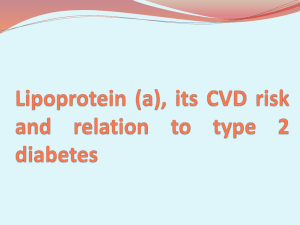Online Appendix for the following JACC article TITLE: Discrimination
advertisement

Online Appendix for the following JACC article TITLE: Discrimination and Net Reclassification of Cardiovascular Risk With Lipoprotein(a): Prospective 15-Year Outcomes in the Bruneck Study AUTHORS: Peter Willeit, MD, PHD, Stefan Kiechl, MD, Florian Kronenberg, MD, Joseph L. Witztum, MD, PHD, Peter Santer, MD, Manuel Mayr, MD, PHD, Qingbo Xu, MD, PHD, Agnes Mayr, MD, Johann Willeit, MD, Sotirios Tsimikas, MD Lp(a) quantification was performed with a double-antibody enzyme-linked immunosorbent assay (ELISA), using an affinity-purified polyclonal apo(a) antibody for coating and the horseradish peroxidase-conjugated monoclonal 1A2 for detection (1). Each sample was analyzed in duplicate, and intra- and interassay coefficients of variation were 2.7 and 6%, respectively. Apo(a) isoforms were determined by sodium dodecyl sulphate-agarose gel electrophoresis (SDS agarose) under reducing conditions using the monoclonal antibody 1A2 for, as previously described (2). The low molecular group included subjects with ≤22 K-IV repeats and the high molecular group with >22 K-IV repeats. If two apo(a) isoforms were detectable, we used only the smaller apo(a) isoform for categorization (2). As for most of the Lp(a) assays, we could rule out that the assay measured apo(a) isoforms independently, therefore we replicated key analyses using simulated “corrected“ Lp(a) levels. The correction procedure implemented apo(a) isoformspecific correction factors as published by Marcovina et al. (3) and is detailed in our previous publication (4). Furthermore, to determine allele-specific Lp(a) levels, we quantified the relative expression of the two isoforms in the SDS agarose electrophoresis and used this information to estimate, for each participant, the amount of Lp(a) associated with low vs. high molecular apo(a) isoforms (defined as above). An Lp(a)-positive serum from Technoclone (Vienna, Austria) calibrated against the IFCC standard preparation PRM02 served as standard throughout the study. Samples were stored for less than 2 years at -80°C before measurement of Lp(a). There was no cycle of thawing and refreezing. LDL cholesterol was calculated by the Friedewald formula. References 1. Kronenberg F, Lobentanz EM, Konig P, Utermann G, Dieplinger H. Effect of sample storage on the measurement of lipoprotein[a], apolipoproteins B and A-IV, total and high density lipoprotein cholesterol and triglycerides. J Lipid Res 1994;35:1318-1328. 2. Kronenberg F, Kuen E, Ritz E et al. Lipoprotein(a) serum concentrations and apolipoprotein(a) phenotypes in mild and moderate renal failure. J Am Soc Nephrol 2000;11:105-15. 3. Marcovina SM, Albers JJ, Gabel B, Koschinsky ML, Gaur VP. Effect of the number of apolipoprotein(a) kringle 4 domains on immunochemical measurements of lipoprotein(a). Clinical chemistry 1995;41:246-55. 4. Kronenberg F, Kronenberg MF, Kiechl S et al. Role of lipoprotein(a) and apolipoprotein(a) phenotype in atherogenesis: prospective results from the Bruneck study. Circulation 1999;100:1154-60.











